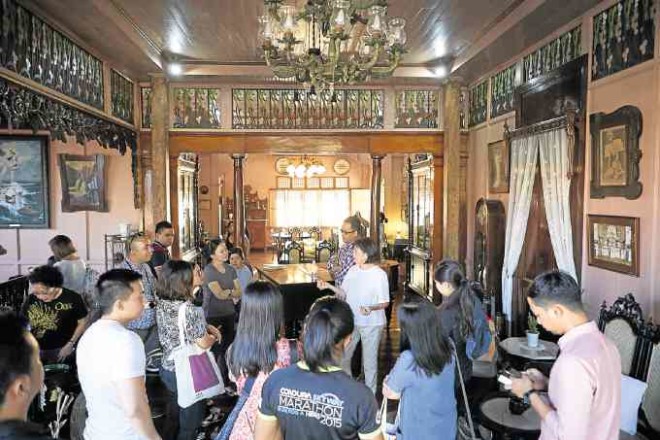
After pleasant visits to General Santos City down south, Isabela up north, and Baler in the east, I just realized that I have missed traveling to my native Laguna. San Miguel Pure Foods Culinary Center’s recent tour in the lakeside province offered a rare chance for me to retrace my roots.
My mother’s family is from Sta. Rosa, Laguna, where I spent summer vacations. Zavalla Street, where her ancestral home sits, is a typical Spanish-era poblacion.
The streets are lined with bahay-na-bato, most notable of which is the imposing Tiongco residence. The structure, which occupies half a block, recalls the image of an age-old house full of memories.
My late grandaunt, Eufrosina Custodio, was a teacher at the Canossa School of Sta. Rosa. It was here where I connected my childhood with the San Miguel tour.
Our first stop was Pila, Laguna, where we viewed the finely preserved heritage houses that line the town plaza. Our guide, Cora Relova, took us to her own ancestral place in Pila,the Corazon Rivera House. The structure is Filipiniana rustic, with capiz windows, high vaulted ceilings and wood paneling.
During the tour, Relova asked us to tell a bit about our roots. I narrated that my late mother was from Laguna.
When Relova heard my surname, she excitedly announced that I am a kababayan and promptly embraced me.
As it turned out, Relova attended Canossa School in her elementary years and was a student of my grandaunt Eufrosina, whom she called Miss Custodio.
Tagalog culture
Relova said that, in her research on Tagalog culture, the Laguna Copperplate Inscription, the earliest known written document in the Philippines, was discovered in Lumban, Laguna.
“Westerners were completely wrong in claiming that Filipinos were barbarians or uncultured natives. The Laguna Copperplate Inscriptions, discovered in 1989, are proof that precolonial Tagalog natives already had a complex system of laws and customs.”
Relova also toured us around the Pila Town Plaza, which was encircled with rows of well-preserved heritage houses.
Apart from Relova’s informative and lively history lessons, she also gave us a taste of Laguna’s culinary delicacies. She served puto Biñan with kesong puti and maja blanca, with refreshing buko juice to wash it all down.
The merienda was delicious, especially the kesong puti, a wonderful Laguna delicacy.
The puto Biñan, with its distinct brownish color, brought back a whiff of nostalgia—it was a snack often served during my growing up years.
Chicken wings adobo
The San Miguel tour’s second stop was in Santa Cruz, at Aurora’s—a restaurant owned and managed by chefs Mon Urbano and Day Salonga. Salonga’s sister, Gel, is also involved in the restaurant’s operations.
Urbano said that Aurora’s is situated within their own house, which was originally built in the 1920s. “Our preservation is fueled by our passion and advocacy in promoting Southern Tagalog cuisine,” he said, adding that many ancestral homes in Laguna are likewise being turned into restaurants, something that enhances the heritage structures in the area.
The trio then demonstrated how to prepare their old family recipe of chicken wings adobo.
The dish, said to be first developed in the 1920s, remains popular in Sta. Cruz.
Other dishes served at dinner were the tinuto, folded gabi leaves mixed with ginger and fish; inalamangang baboy, fresh alamang sautéed in pork pieces; pansit chami, stir-fried egg noodles; and crispy adobong tadyang ng bakang Angus, twice-cooked 500-gram Angus short ribs.
Gel also showed us how to prepare Aurora’s trademark dessert, the baked bibingka cheesecake. The use of La Pacita Graham Crackers added flavor to the treat.
Boutique hotel
After the first day of the tour, we stayed at the beautiful Sulyap Gallery Café in San Pablo City. The property is a charming boutique hotel with a Filipiniana design aesthetic, its wood details sourced from heritage houses all over the country.
Sulyap also houses a museum filled with antiques and quaint wooden carvings.
For breakfast, we sampled the Magnolia pancake station in Sulyap’s al fresco area. We also tried the fried bangus and pork tapa at the breakfast buffet.
This being a San Miguel food tour, the spread included the brand’s Barako instant coffee, which I particularly liked.
And then we ventured to the nearby Café Lago at the shoreline of the picturesque Sampaloc Lake. The lake has gone through a renaissance in recent years, and is now as clean and beautiful as many lake towns in the United States and Europe.
Café Lago owners Tony and Mandy Marino were on hand to tour us around their shop, which affords guests a relaxing view of the lake. Cool, clean-smelling air is a constant at the café, lending it an ambiance like that of Tagaytay or Baguio.
The siblings served us the cafe’s famed buttered chicken made special with Star Margarine. The flavor triggered many fond memories—of long afternoons spent playing with cousins and then snacking on pan de sal slathered with the staple margarine.
A deconstructed halo-halo was served—fried lumpia filled with ube halaya, nata, kaong and beans, topped with Magnolia vanilla ice cream. It was a fitting ending to a dreamlike adventure. —CONTRIBUTED
Visit www.homefoodie.com.ph to know more about San Miguel Pure Foods and its recipes.